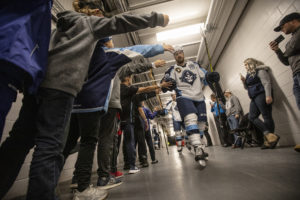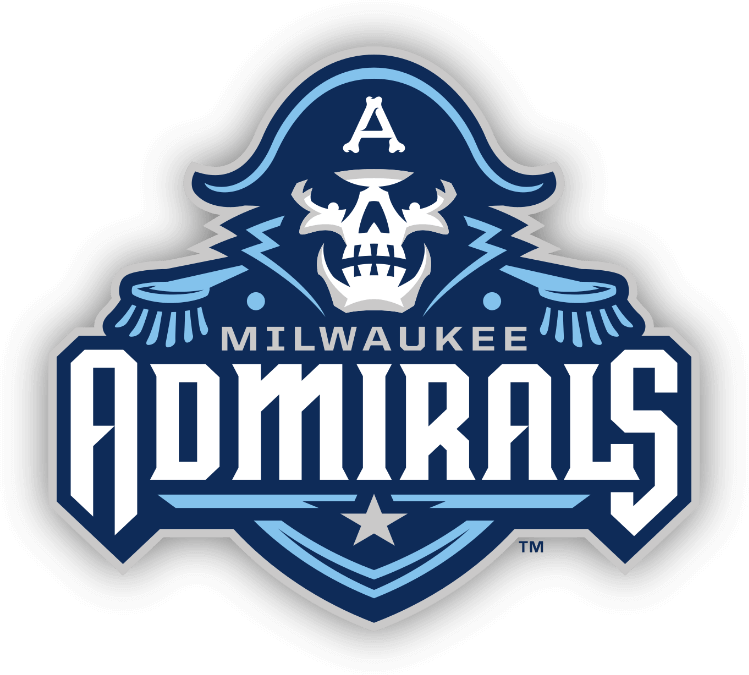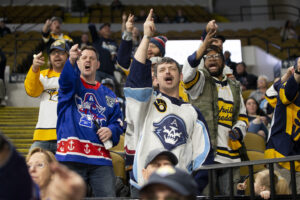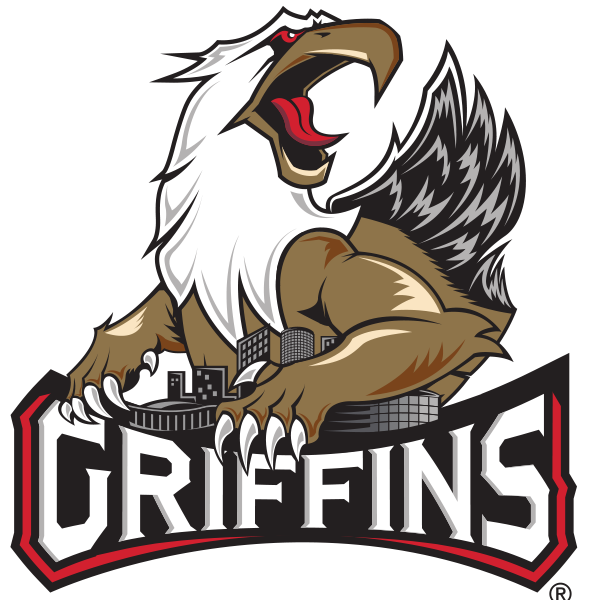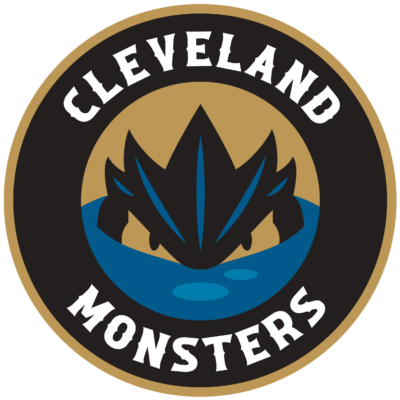THE TWO MAIN RULES
Once you’ve mastered the two basic rules, you’ll be on your way. They are Offside and Icing. These rules help ensure the fast paced action of hockey.
Offside—When any member of the attacking team crosses the defending teams’ blue line before the puck. Play is stopped and a face-off is held in the neutral zone outside the defending teams blue line.
Icing the Puck—When a player shoots the puck up the ice from his side of the centerline and across the opponent’s goal line, and an opposing player touches the puck, icing is called. Play is stopped and a face off is held in one of the circles at the offending team’s end of the ice. This rule does not apply to a team playing shorthanded due to a penalty or if the puck goes into the opponent’s goal.
Face-off —The means by which the puck is put into play to start a game or to continue it after goals, penalties, or other instances where the clock stops. Centers are usually matched in a face-off.
A team scores when one of its shots goes into the opposing teams goal. Players who help set up a goal get an assist, but only two assists can be scored per goal. For personal scoring record, one point is given to each player for a goal or assist, but the team gets just a single point for each goal.
Games last 60 minutes and are divided into three periods of 20 minutes each. Intermissions between periods permit the players to rest and to resurface the ice sheet.
In the event that the teams are tied after regulation, they will play a five-minute, four-on-four, sudden death overtime period. Should the teams remained tied after the overtime period a shoot-out would occur. Each team chooses five skaters to take alternating penalty shots. The team with the most “goals” after five attempts wins. If the two teams are still tied after five shooters, the two teams would alternate shooters until one of the team scores and the other does not.
THE RINK
A hockey rink is 200’ x 85’. It is composed of two attacking zones and a neutral zone. The attacking zones are 60’ and are measured from the blue line to the goal line (the red line that runs through the crease). The area between the edge of the boards to the goal line is 11’. The neutral zone is 58’ and is measured from blue line to blue line.
EQUIPMENT
The Goal-The goal is six feet wide, four feet high, and curving from one to three feet deep in a double “Dimple.” Twine netting covers the sides and back. The goal is red except for the white rear base. Pins anchor it to the ice. To score a goal, the puck must completely cross the goal line at the mouth of the goal. The “crease” for goaltenders is eight feet wide and four feet deep.
Sticks-Must not exceed 53 inches from heel to end of shaft. Blade size limits are 14 ¼ inches by 3 inches. Average player uses 2 to 4 dozen a season.
The Puck-Made of vulcanized rubber, 3 inches in diameter, 1 inch thick and weighing between 5 ½ and 6 ounces. Frozen for several hours before a game to eliminate bounces. More than a dozen are used in most games. Reaches speeds of up to 100 mph on shots.
OFFICIALS
Referee-Supervises the game and is in complete charge. Starts the game, calls penalties, determines goals, and handles face-offs in the defending zones. Wears red/orange band on arm.
Linesman-Two are used. They call off-sides, icing the puck, and handle face-offs in the neutral zone. They do not call penalties, but recommend to the referee that penalties be called.
Goal Judge-Sits off-ice behind each net and indicates when a goal is scored by turning on the red light just above his station. The referee can overturn any call made by the goal judge.
HOCKEY VOCABULARY
Back Check-Attempts by forwards on their way back to the defending zone to regain the puck. (Legal)
Body Check-Using hip and shoulder to slow or stop an opponent with the puck.
Breakaway-The puck carrier getting in front of all opponents except goalkeeper.
Breakout-When a team comes out of its defensive zone and starts up the ice toward the opponent’s goal.
Drop Pass-Puck carrier leaves the puck behind for a trailing teammate to pick it up.
Fore Check-Keeping opponents at their end of the rink while attempting to regain possession of the puck.
Freezing the Puck-Holding the puck against the boards using sticks or skates.
Hat Trick-Three goals scored by one player in one game.
Headmanning-Passing the puck forward to a leading teammate, usually used when breaking the puck out of your own zone.
Neutral Zone-Center ice between attacking and defending areas.
Penalty Box-Area off ice at red line where penalized players serve their “sentences” and feel much shame.
Poke Check-Stabbing at the puck with the blade of the stick to take it away from the puck carrier. (Legal)
Power Play-While an opponent is shorthanded due to penalty, the team with the manpower advantage sends five men with the puck into the attacking zone.
Slap Shot-Bringing the stick back and quickly forward, slapping the puck ahead.
Splitting Defense-Man with the puck goes between two defenders.
Stick Handling-Carrying the puck along the ice with the stick.
Sweep Check-Using the entire length of the stick while laying it flat on the ice in order to take the puck away from the carrier. (Legal)
Wrist Shot-Flicking motion of the wrist to propel the puck off the blade.
THE SIX MEN AND WHAT THEY DO
Each team plays six men at one time (unless someone has been put in the penalty box) and a roster can include as many as 19 players. Substitutions are made while play is in progress. The positions are goaltender, left/right defense, center, and left/right wings.
Goaltender—By any method he can employ, the goalie’s number one responsibility is to keep the opposition from putting the puck into his goal. Offensively, he starts his team down the ice with a pass, but seldom leave the net he guards to take part in any attacks at the opposing goal.
Defensemen—They try to stop the incoming play at their own blue line. They attempt to block shots, cover opposing forwards and clear the puck from in front of their own goal. On offense they get the puck to the center and wings and follow the play into the attacking zone to maintain the offensive momentum.
Center—The middle of the ice from end to end is his primary territory, leading the attack by carrying the puck on offense. He exchanges passes with the wings to steer the play toward the enemy goal. On defense he tries to break up a play before it gets on his teams side of the ice and continues to harass their play in the neutral and defensive zone. There are varied systems employed that would change or alter these duties.
Wings—Moving up and down the sides of the ice with the direction of the play, the wings work with the center on the attack to set up shots at the goal. Defensively, they try to disrupt plays by the opposing wings and block their shots.
Hockey does not employ a variety of set plays such as football. Instead, the players must react from instant to a variety of situation. Teamwork is key.
PENALTIES
Hockey is unique in that several times during a game both teams will be forced to play shorthanded when one or more of its players are put in the penalty box. However, no team is forced to play more than two men below full strength (6 men) at any time. If a third penalty is called it is suspended until the first penalty expires. On penalties called on the goalkeeper, a teammate serves his time in the penalty box.
When penalties reduce a team’s strength, it changes its style of play, concentrating on defense. Meanwhile the opponent loads his lineup with offensive players in an effort to capitalize on superior number. Except for major or match penalties, the shorthanded team returns to full strength as soon as the opposition scores.
TYPES OF PENALTIES
Minor—Minor penalties are two minutes in length and include: Tripping, hooking, boarding, spearing, slashing, roughing, holding, high sticking, elbowing, and charging.
Major—Major penalties are five minutes long and are usually called for fighting or when a minor penalty is committed with deliberate attempt to injure.
Match—For deliberately injuring an opponent. The team must play shorthanded for five to ten minutes, with the severity of the injury determining the length of the assessment. The offending player is kicked out of the game.
Penalty Shot—A free shot, unopposed except by the goalie, is given to a player who is illegally impeded from behind when in possession of the puck and with no opponent between him and the goal except the goalie. The team that commits the offense is not penalized beyond the penalty shot, whether it is successful or not.
OFFICIAL SIGNS
BOARDING-Driving opposing player violently into boards with bodycheck.
ELBOWING-Using an extended elbow in a manner that may or may not cause injury.
HIGH STICKING-The carrying of sticks above the height of the shoulders, so that injury to the face or head results.
HOOKING-The use of the stick in tripping or otherwise impeding the progress of the opponent.
INTERFERENCE-When a player interferes with or impedes the progress of an opponent without the puck.
HOLDING-Holding the opponent using hands, arms, or legs.
TRIPPING-Upsetting player either through means of your foot or stick.
CROSS CHECKING-A check or block delivered by a player with both hands on the stick and no part of the stick on the ice.
CHARGING-Taking a run at an opposing player using more than three strides to build up speed.
WASH OUT-When used by the Referee it means goal disallowed, by Linesman it means there is no offside.
SLASHING-Striking opposing player with stick.
MISCONDUCT-10-minute or disqualification penalty for excessive or additional misbehavior on the ice.

